Papers by Michelle R Ellefson
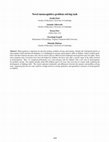
Cognitive Science, 2017
Metacognition is important for decision making, problem solving and learning. Despite the widespr... more Metacognition is important for decision making, problem solving and learning. Despite the widespread interest in metacognitive skills and their development, it is challenging to measure metacognitive skills in children. Some excellent qualitative and observational measures exist, but use metrics that are different from traditional metacognition tasks for adults. Some meta-cognition tasks of memory have been developed for children, but these only offer a narrow range of the skills involved in metacognition. Here, we compared performance on a meta-memory task for children with a new task of metacognition for problem solving. Our sample includes about 800 children aged 8-10 years who were part of a larger study exploring the development of thinking skills. The results indicated similarities and differences between the memory and problem solving tasks, suggesting that the new task could be a bridge between existing qualitative and quantitative measures of metacognition in children.
Executive functions and play
Trends in Neuroscience and Education
Developmental Science, Sep 15, 2022
When compared to research centered on the executive function development of white, middle-class c... more When compared to research centered on the executive function development of white, middle-class children, relatively little is known about their non-white, low socioeconomic status peers. In an effort to harmonize how executive functions are measured within under-represented contexts, the present study addresses gaps in the evaluation of everyday executive functioning to better understand whether behavior rating scales completed by teachers (BASC2 EF-BASC executive function scale, 2nd edition; BASC3 EF-BASC executive function scale, 3rd edition) capture distinctions between performance-based measures. This study includes two large samples of older, ethnic minority children from high-poverty backgrounds (Sample 1. N = 243; M age = 9.28 years, SD age = 0.80;
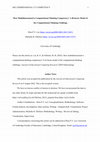
Computational thinking (CT) is an emerging and multifaceted competence important to the computing... more Computational thinking (CT) is an emerging and multifaceted competence important to the computing era. However, despite the growing consensus that CT is a competence domain, its theoretical and empirical account remain scarce in the current literature. To address this issue, rigorous psychometric evaluation procedures were adopted to investigate the structure of CT competency, as measured by Computational Thinking Challenge (Lai, 2021b), in a large sample of 1,130 British secondary school students (Mage = 14.14 years, SDage = 1.45). Based on model comparison from an exploratory multidimensional item response theory approach, the results supported the multidimensional operationalization of CT competency. A confirmatory bi-factor item response theory model further suggested CT competency is comprised of a general CT competency factor and two specific factors for programming and non-programming problem-solving. Despite the multidimensionality, the common variance is largely explained b...
Studying Cognitive Development in School‐Aged Children
The Encyclopedia of Child and Adolescent Development
This entry presents different methods for studying the cognitive development of school‐aged child... more This entry presents different methods for studying the cognitive development of school‐aged children between 6 and 12 years of age. More specifically, it focuses on cognitive tasks, processing speed, and verbal reasoning. First, some examples of the tasks used to measure a variety of cognitive skills are evaluated. Second, the utility and limits of response time metrics as well as neurophysiological, electrophysiological, and imaging techniques are discussed. Third, tasks that allow children to explain their experiences and ideas are examined.
Psychonomics 2018: Pretend Play & Language Poster
Pretend Play and Children's Self-Regulation and Language Skills: An Interventional Study
16 Linguistic Adaptation without Linguistic Constraints: The Role of Sequential Learning in Language Evolution
The acquisition and processing of language is governed by a number of universal constraints, many... more The acquisition and processing of language is governed by a number of universal constraints, many of which undoubtedly derive from innate properties of the human brain. These constraints lead to certain universal tendencies in how languages are structured and used. More generally, the

School-based Intervention Studies: Handling Real-World Practicalities and Problems
There is a need for more evidence-based research in education and research; however, the difficul... more There is a need for more evidence-based research in education and research; however, the difficulty of conducting interventional research in educational settings is often less acknowledged. This article provides practical examples when implementing school-based interventions, and highlights the importance of designing a multifaceted, cost-effective intervention, especially when working with hard-to-reach families. Additionally, the article notes the importance of being consistent and attentive to the developmental stage of the children and supporting parental engagement, two aspects that are crucial to the implementation of the intervention. The article also provides suggestions for building the researcher-practitioner relationship from study onset, and outlines the use of scaffolding, positive reinforcement, and play-based learning strategies over the course of the intervention to support child outcomes.

Two-Generational Reports of Parenting in Hong Kong and England: Beyond Autonomy Support and Psychological Control
Understanding parents’ roles in shaping child development necessitates studies including parents ... more Understanding parents’ roles in shaping child development necessitates studies including parents and children across different cultures. Here, we use a multi-dimensional, multi-informant approach to investigate parenting across two different cultures: Hong Kong and England. Participants from late childhood to early adolescence (ages 9 to 16 years) and their parents (N = 1410) answered questions on six parenting dimensions: autonomy support, psychological control, warmth, rejection, structure and chaos. Differential item functioning occurred across sites and generations. Generation effects were stronger than site effects, with parents being more positive. Consistent correlations across sites indicated that children had a unidimensional view of their parents. In contrast, parents seem to hold a more multi-dimensional view that is not fully consistent across sites.
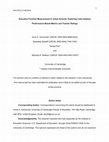
When compared to research centered on the executive function development of white, middle-class c... more When compared to research centered on the executive function development of white, middle-class children, relatively little is known about their non-white, low socioeconomic status peers. In an effort to harmonize how executive functions are measured within under- represented contexts, the present study addresses gaps in the evaluation of everyday executive functioning to better understand whether behavior rating scales completed by teachers (BASC2EF – Karr & Garcia-Barrera, 2017; BASC3EF – Reynolds & Kamphaus, 2015) capture distinctions between performance-based measures. This study includes two large samples of older, ethnic minority children from high-poverty backgrounds (Sample 1. N = 243; Mage = 9.28 years, SDage = 0.80; nfemale = 125; nAfricanAmerican = 216, nLatinAmerican = 15, nAsianAmerican = 6; Sample 2. N = 229; Mage = 10.02 years, SDage = 1.01; nfemale = 120 nAfricanAmerican = 132, nLatinAmerican = 92, nWhite = 3, nPacificIslander = 1). Based on structural equation model...
The Influence of Pretend Play on Children's and Language and Pre-Literacy Skills
Cognitive Science, 2018
Cognitive Science, 2013
Although reasoning skills have been investigated in a number of different domains, very little is... more Although reasoning skills have been investigated in a number of different domains, very little is known about how children and adults use them in chemistry. Here, participants from 4 years to adults saw various mixtures presented using a standard property induction paradigm. The category and appearance of everyday materials were varied to assess the extent that participants use these features to inform their judgments about what happens when these materials are mixed with water. In general, the results followed similar patterns seen when this paradigm has been applied to other domains, with both category and appearance informing inductive generalizations. The findings contrast with interview-based measures of children’s understanding of chemistry and offer an important addition to the field.

Causal Parsimony in Learning Science Hima Khamar Virginia Commonwealth University Michelle Ellefs... more Causal Parsimony in Learning Science Hima Khamar Virginia Commonwealth University Michelle Ellefson Virginia Commonwealth University Christian Schunn University of Pittsburgh Abstract: The ability to understand scientific phenomena entails the creation of appropriate models of relations among variables, frequently in causal form. In the chemical world multiple factors interact to produce outcomes, e.g., chemical reactions occur only when multiple reactants react to create new product(s). Do students simply add new information to their mental models, or do they follow some sort of causal parsimony replacing old ideas with new ones? We captured students causal models of chemical phenomena and examined whether these models changed after instruction designed to foster in-depth causal understanding of chemistry concepts. The results from concept mapping activities suggest that students used causal parsimony, replacing some of their na¨ive conceptions with what they learned while creating...
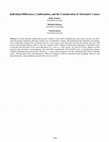
Cognitive Science, 2015
In causal inference, people place greatest weight on cases where a hypothesized cause and its out... more In causal inference, people place greatest weight on cases where a hypothesized cause and its outcome are simultaneously present, potentially reflecting a positive test or confirmatory strategy. We hypothesized that individuals may display more confirmation seeking when an outcome has few, versus many, causal alternatives and that this relation may vary with actively open-minded thinking (AOT) or need for cognition (NFC). Subjects learned about implausible or plausible causes of outcomes that had many or few causal alternatives (e.g., stress vs. colon cancer). On each of 16 trials, subjects received frequency data and made a causal judgment, after which they completed the AOT and NFC scales. As hypothesized, subjects weighted confirming data more heavily with fewer vs. many causal alternatives, but this relationship only held for plausible causes. AOT interacted with causal alternatives: With few alternatives, AOT was unrelated to data-weighting. However, with many alternatives, dat...
Cognitive Science 2017: Zoo Task Poster
Poster Presented at the Annual Meeting of the Cognitive Science Society (London, UK)
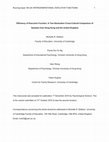
While Asian preschoolers acquire executive functions (EFs) earlier than their Western counterpart... more While Asian preschoolers acquire executive functions (EFs) earlier than their Western counterparts (e.g., Sabbagh, Xu, Carlson, Moses & Lee 2006), little is known about whether this advantage persists into later childhood and adulthood. Addressing this gap, the current study presented four computerized EF tasks (providing measures of inhibition, working memory, cognitive flexibility and planning) to a large sample (n = 1,427) of 9to 16-year-olds and their parents living in the United Kingdom and in Hong Kong. Highlighting the importance of combining developmental and cultural perspectives, our findings showed both similarities and contrasts across sites. Specifically, adult EF performance did not differ across sites and agerelated changes in EF for both children and parents as well as a modest intergenerational correlation appeared culturally invariant. In contrast, school-aged children and young adolescents in Hong Kong outperformed their UK counterparts on all four EF tasks, consi...
Failure of replication attempts in experimental psychology might extend beyond p-hacking, publica... more Failure of replication attempts in experimental psychology might extend beyond p-hacking, publication bias or hidden moderators; reductions in experimental power can be caused by violations of fidelity to a set of experimental protocols. In this paper, we run a series of simulations to systematically explore how manipulating fidelity influences effect size. We find statistical patterns that mimic those found in ManyLabs style replications and meta-analyses, suggesting that fidelity violations are present in many replication attempts in psychology. Scholars in intervention science, medicine, and education have developed methods of improving and measuring fidelity, and as replication becomes more mainstream in psychology, the field would benefit from adopting such approaches as well.
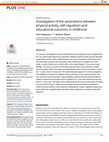
It is common knowledge that physical activity leads to physiological and psychological benefits. ... more It is common knowledge that physical activity leads to physiological and psychological benefits. The current study explored the association between physical activity and self-regulation longitudinally and the indirect relationship this may have on academic achievement, using secondary data on primary and secondary school children from the Millennium Cohort Study, a cohort of infants born in 2000–2001 in the United Kingdom. There are two main findings. First, there is a positive link between physical activity and emotional (not behavioural) regulation both concurrently and longitudinally across all three time points, 7-years-old, 11-years-old and 14-years-old. The relationship was negative for emotional regulation and negligible for behavioural regulation when controlling for socioeconomic status. Second, across two time points (due to data availability), physical activity positively predicted academic achievement through emotional regulation for 7-year-olds and behavioural regulatio...

Metacognition is important for monitoring and regulating cognitive processes, decision-making, pr... more Metacognition is important for monitoring and regulating cognitive processes, decision-making, problem-solving and learning. Despite widespread interest in metacognition, measuring metacognition in children poses a significant challenge. Some qualitative and observational metrics exist, but are restricted by scalability, range of metacognitive components measured, and use of different metrics compared with tasks for adults. We developed the Zoo Task - a novel, scalable, paper-based task that measures multiple aspects of metacognition that is less conflated by other variables like verbal ability and does not require video recording children. Children (N = 204, ages 7-12 years, mostly from African American backgrounds) attending schools in high poverty urban areas contributed to its development. In addition, they completed a standard metacognition of memory task similar to those already used with children and adults. The results indicate that the novel task trials are reliable and hav...





Uploads
Papers by Michelle R Ellefson